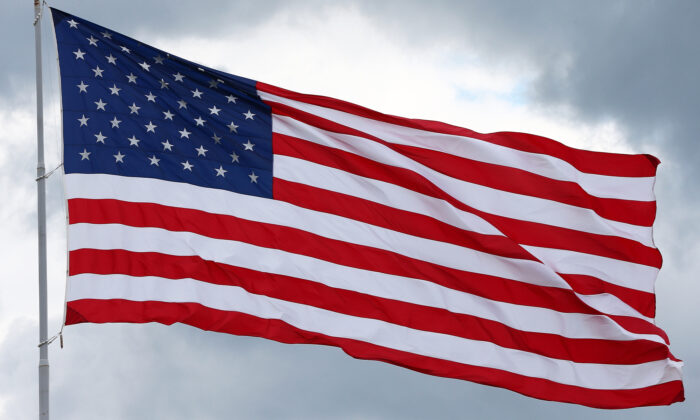Commentary
As a young child, I was taught by my parents the fundamental rules of respectful treatment for the American flag: “The flag should never touch the ground” and “It must be destroyed in a dignified manner when it is no longer in fit condition to display.” However, I was unaware of the origins of these customs until I delved into the history behind them. During the Golden Era of Hollywood, both films and the American flag had standards of decency that were not mere coincidences.
The Flag Code and the Motion Picture Production Code were the driving forces behind these high standards. The Production Code, enforced from 1934 to 1954, aimed to regulate proper film content, famously known as the Hays Code after Will Hays, Hollywood’s ambassador of goodwill. While most people associate the Code with issues like profanity, nudity, and violence, its primary purpose was to help films avoid censorship, both domestically and internationally. It steered filmmakers away from offensive content, including topics related to foreign relations, politics, and even patriotic principles aligned with the Flag Code.
A Grand Old Costume
One of the few patriotic principles explicitly stated in the Production Code was the requirement for filmmakers to show respect for the flag. Desecrating the flag in standard ways, such as letting it touch the ground or displaying a tattered banner, was largely unheard of in Hollywood. However, an incident in 1946 shed light on a different aspect of flag etiquette that most people overlook today: attire.
In his memoir titled “See No Evil: Life Inside a Censor,” Jack Vizzard recounted a situation where he had to defend the honor of the flag against a film producer. The producer had included a scene in which a child dancer twirled her cape, transforming it into an American flag. Given the post-war sentiments of heightened patriotism and sensitivity towards the flag, Vizzard, enforcing the Code, deemed this portrayal disrespectful.
Vizzard’s confrontation with the producer led to a debate over whether using the flag as a costume violated the Code’s mandate to show consistent respect for the flag. Ultimately, Vizzard’s adherence to the Code won out, as an officer from the corporation confirmed the prohibition on using the flag as part of a costume. Despite the producer’s initial resistance, the flag was not to be exploited for artistic purposes in this manner.

My mind made a decision. Bill was right. And right is right. I will confront those individuals in New York. I will succeed! Keep going, young lady, twirl!
“She did.
“The outfit was all navy blue, inside and out.
“Bill, for his own mysterious reasons, had a change of heart.
“Is this not a reason to make the pun that, for once, Wright was wrong?”
The Flag Code
I agree with Jack Vizzard in this instance. The scene, originating from an unknown film, was not meant to be disrespectful. However, it did violate an important Code – not the Motion Picture Production Code, but the United States Flag Code. This Code was established on June 14, 1923, to prevent the improper use of the flag in advertising and merchandise, and was made law in 1942. Title 36, Chapter 10 of the United States Code addresses Patriotic Customs, including Sec. 176: “Respect for flag.”
“(d) The flag should not be used as clothing, bedding, or drapery. It should be allowed to hang freely without being folded or drawn back. Bunting in blue, white, and red should be used for decoration, with the blue on top, white in the middle, and red on the bottom.
“(j) No part of the flag should be used as a costume or uniform. However, a flag patch may be worn by military personnel, firefighters, police officers, and members of patriotic organizations. The flag is a symbol of a living country and should be treated as such. Therefore, a flag pin should be worn on the left lapel near the heart.”
Modern American culture often disregards these rules. Patriotism is displayed through flag-themed clothing, from t-shirts to bikinis, which is not respectful. The flag should be depicted on a solid piece of material, or patriotic attire should be based on the flag’s colors and patterns rather than the flag itself. The flag should be revered, not flaunted.
Respect for the Flag
The gentleman from the New York office likely quoted the Flag Code to Mr. Vizzard. Despite feeling ridiculous, it was right to prevent even minor uses of the flag in costumes. Allowing one flag cape could lead to a trend of flag clothing, undermining the importance of respecting the flag.
Respecting the flag is crucial to our nation’s heritage. Let us always honor our flag and pay attention to the rules outlined in the United States Flag Code, in addition to the Motion Picture Production Code.
Views expressed in this article are the author’s opinions and do not necessarily reflect those of The Epoch Times. Please rephrase the following sentence:
“The company’s new marketing campaign is expected to increase sales by 20%.”
The new marketing campaign from the company is anticipated to drive a 20% increase in sales.
Source link





